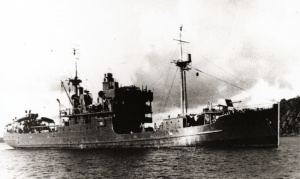Yandra was requisitioned from the Coast Steam Ship Company, Adelaide, South Australia, on 27 June 1940. Following conversion to an anti-submarine vessel at Sydney, it commissioned in the Royal Australian Navy (RAN) on 22 September 1940 under the command of Lieutenant James A Taplin RANR(S).
Yandra spent the first 6 months of its war based in Fremantle, Western Australia, where it undertook routine patrol duties before returning briefly to Sydney. It returned to western Australian waters in June 1941 and remained there until early 1942.
During this time the light cruiser HMAS Sydney (II) was sunk off the western Australian coast following an action with the German auxiliary cruiser HSK Kormoran on 19 November. Days after its loss a wide scale air and sea search was launched during which Yandra recovered one of the Kormoran’s lifeboats containing 72 survivors comprising 2 German officers, 68 German sailors and 2 Chinese sailors. This boat was subsequently landed at Carnarvon. No member of Sydney’s crew of 645 was found.
In January 1942 Yandra returned to Sydney where it conducted patrol and escort duties along the eastern seaboard. On the night of 31 May 1942, it was patrolling the entrance to Sydney Harbour when 3 Japanese miniature submarines evaded detection and penetrated the harbour defences. The alarm was raised in the harbour when one of the miniature submarines became entangled in the anti-submarine boom net that stretched across the inner harbour. At 10.37 pm the commander of this miniature submarine, Lieutenant Kenshi Chuman, realising the hopelessness of his situation, detonated scuttling charges which destroyed the vessel killing himself and Petty Officer Takeshi Omori.
The blast reverberated around Sydney Harbour alerting Yandra’s captain, Lieutenant Taplin, to the threat. He immediately altered course towards the inner harbour to investigate and quickly spotted a conning tower about 360 metres ahead of him. Increasing speed, he pursued the submarine towards the eastern channel and attempted to ram it. There is little doubt that Yandra struck the submarine a glancing blow, damaging the protective cage around its torpedo tubes which prevented it from firing its deadly cargo. The submarine, later identified as M-21, was crewed by Lieutenant Keiu Matsuo and Petty Officer First Class Masao Tsuzuku.
Following Taplin’s initial attack, Yandra reversed course and next sighted the submarine approximately 550 metres on its starboard bow moving very slowly from left to right. Taplin immediately pressed home a depth charge attack, the result of which was inconclusive. Unfortunately, Yandra sustained damage in this attack, due to its close proximity to the explosion of its own depth charges, and was forced to withdraw from the action to effect repairs.
Matsuo’s damaged submarine was later disabled in Taylor’s Bay by the channel patrol boats Sea Mist and Steady Hour. The miniature submarine’s crew were found dead inside the vessel when it was later salvaged. It appears that Matsuo first shot Tsuzuku before turning his gun on himself to avoid capture.
The 3rd Japanese miniature submarine crewed by Sub Lieutenant Katsuhisa Ban and Petty Officer First Class Mamoru Ashibe managed to fire its torpedos at the American cruiser USS Chicago, however, the torpedos missed their intended target and struck the depot ship HMAS Kuttabul which was secured alongside the sea wall at Garden Island. Twenty-one sailors were killed because of the attack. The submarine later escaped the harbour but failed to rendezvous with its parent ship. Its wreck was found by recreational divers north off Newport Reef, Sydney in November 2006.
Following the attack on Sydney Harbour, Yandra remained in eastern Australian waters conducting routine patrol, anti-submarine and escort duties which extended as far north as New Guinea. It paid off at Port Adelaide on 25 March 1946 and was returned to its owners in July that year. It was wrecked on 25 January 1959 on Neptune Island, Spencer Gulf, South Australia.
Specifications
 |
| Type |
Requisitioned Patrol Craft |
|---|---|
| Pennant |
FY91 |
| Builder |
Copenhagen, 1928 |
| Commissioned |
22 September 1940 |
| Decommissioned |
25 March 1946 |
| Dimensions & Displacement | |
| Displacement | 1620 tons |
| Length | 216 feet |
| Beam | 35 feet 2 inches |
| Draught | 11 feet 9 inches |
| Performance | |
| Speed | 11 knots |
| Complement | |
| Crew | 6 Officers and up to 53 Ratings |
| Armament | |
| Guns |
|
| Other Armament |
|
| Awards | |
| Battle Honours | PACIFIC 1941-45 |